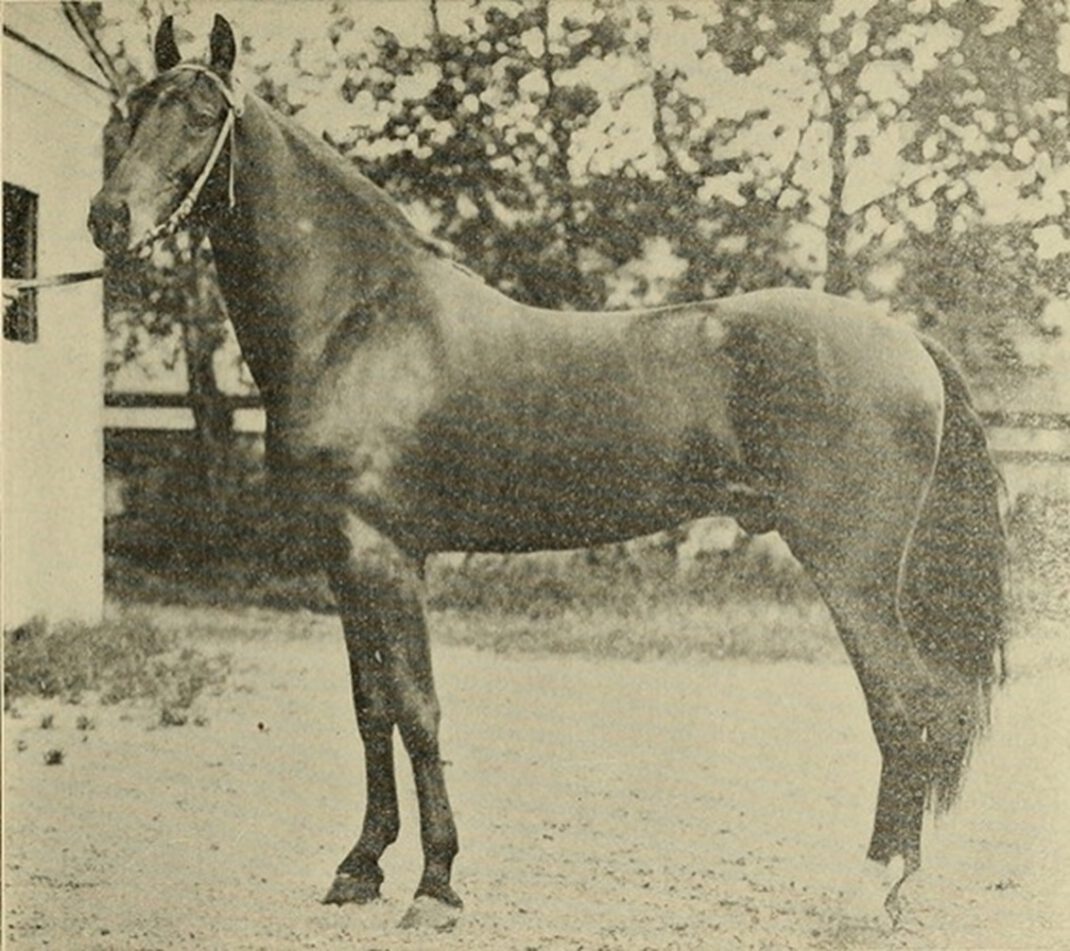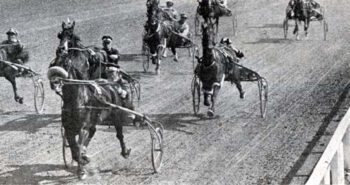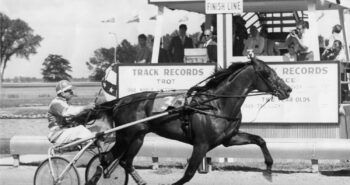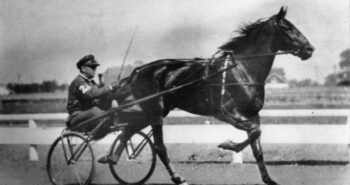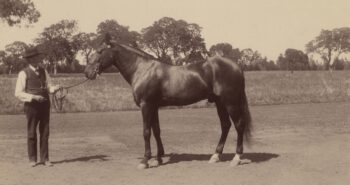J Malcolm Forbes was one of the biggest owners and breeders of standardbreds from 1890 until his death in 1904. Forbes shelled out massive amounts for several horses including Nancy Hanks and Arion. The millionaire believed the best of all the horses he owned, though, was a lesser known horse called Vice Commodore. A horse who left a lasting legacy through two daughters, but whose death wasn’t even noticed when it happened.
Exceptionally blue blooded, Vice Commodore is a son of Bingen and Narion, herself the daughter of Arion and Nancy Hanks. Breeder and owner J Malcolm Forbes adored the young colt, who had trotted in 2:21 in an exhibition at 2, and considered him the most promising he had bred. In early March 1904, when Vice Commodore was three years old, his wealthy breeder died. On Mar 30 it was reported in numerous American newspapers that “another offer has been made the estate for one of three-year-olds of $10,000 – the bay colt Vice Commodore, by Bingen 2:06 1/4 (1.18,5) out of Narion by Arion 2:07 3/4 (1.19,4), second dam Nancy Hanks 2:04 (1.17,1). This youngster, on breeding is well worth every dollar that has been tendered for him, but at that will likely bring more when led into the sale ring, especially when buyers will have but the one opportunity in life to secure a sire of such royal lineage.” The previous year Vice Commodore had trotter 2:21 (1.27,6) as a two-year-old.
The offer, however, was refused. Vice Commodore was one of the horses in the estate auctioned off by the Tranter-Kenney Company between May 23 to May 28. Auction prices were nowhere near what had been hoped for though, as Andy J Welch of Hartford, CT bought Vice Commodore for $6,900 and assigned him to trainer John Shillinlaw. At the end of the year it was reported that Welch and Shillinlaw would not race the colt until he was five, despite Vice Commodore looking good in training. On Nov 3, at trained a mile in 2:25 (1.30,1), the last half in 1:07 and last quarter in 31 1/2 seconds.
Almost sold to England
In January 1905 the four-year-old was almost sold off to England. An article in Hartford Courant on Jan 11, 1905, stated that the colt was shown “to some English horsemen who are anxious to buy the animal for racing and breeding purposes”, and went on to say that Welch was asking for $15,000 for the Bingen-son. Furthermore, “if the horse is not sold to the English parties who are now after him he will be kept in the stud until he is 6 years old and will be started for the stallion championship. Besides being fast and having the best of blood, Vice Commodore is a beautiful show horse and stands 15,2 hands high (157,5 cms).” The matter was not reported on any further, so it’s safe to say the interested parties failed to meet the owner’s asking price.
Despite not racing yet, Vice Commodore was starting to get a reputation for his abilities. In newspaper The Day on May 22, 1905 it was reported that Vice Commodore “is the talk of every trainer at Charter Oak. After seeing him trot an eighth one morning last week Jim Gatcomb and Dave McClary both booked mares to him.”, and a week later the Boston Globe wrote that “John Shillinglaw expects to drive Vice Commodore a mile in 2:10 (1.20,8) this fall.”
On Nov 22, 1905, the Lexington Herald-Leader reported that Vice Commodore had arrived in Kentucky to head a private breeding stud that Welch was setting up in the state. Furthermore, Welch was going to buy “twenty royally-bred mares and these stud matrons will all be mated to Vice-Commodore in the spring.”
Finally getting a record
In addition to stud duty, Welch wanted his stallion to get a good record. In the spring of 1906 he assigned Vice Commodore to trainer George B Hayes. Because he was a popular stallion Vice Commodore didn’t race in 1906, but a few exhibition miles in 2:15 (1.23,9) earned the colt several more bookings for 1907. On Dec 17, 1906, the Boston Globe had an article on Vice Commodore for the upcoming season. “Hayes jogged Vice Commodore this season while the horse was doing stud service, and while he never asked him to go a mile better than 2:17 (1.25,1), he let him down a half once in 1:02 3/4 (804 meters in 1.18), and several times drove him quarters in 31 seconds and eights at a 2-minute clip.
Vice Commodore is a natural trotter, with simply a whirlwind of speed, and his trainer believes he will be a sensational racehorse in 1907. He will come on the turf as a matured horse of 6 years of age and he has had no training to speak of since he was a 2-year-old. He is as sound now as the day he was foaled. As a 2-year-old he showed a mile in 2:21 (1.27,6), and Henry Titer who developed him, said at that age he could outtrot any 2:15 horse through the stretch.
(…)
Hayes is not alone in the belief that Vice Commodore will be the Nutboy of 1907. Many other local trainers regard his credentials for high racing honors next season as second to no horse without a record in the land. Some even go further and actually predict he will ultimately wear the stallion crown.”
The two daughters
At he end of January 1907, however, Welch sold, reportedly for a price of $10,000, Vice Commodore to Edward and Joseph Madden, who announced they would move the colt to trainer Knap McCarthy. That didn’t happen, though, and the Bingen son remained with Hayes. The Madden brothers were more preoccupied with breeding than racing the stallion, and again skipped on the big races, but on Oct 26, 1907, he finally time trialed in 2:11 (1.21,4) at Lexington.
In 1908 it made the news when Silicon gave birth to a colt by Vice Commodore, the newly born a brother to Kentucky Futurity-winner Silico. However, it would be two other 1908 foals, both bred by the Maddens, that would immortalize Vice Commodore. One was Margaret Parrish. Early in 1910 rumors could be heard about the two-year-old filly on the jungle telegraph. Margaret Parrish turned out to be a top trotter, time trialing in 2:06 1/4 (1.18,5) at 4, but it was as a broodmare she is forever remembered.
The second 1908-foal is the unknown Nanceala. With the latter a daughter of Nancy Hanks, Nanceala was 3×2 inbred on Nancy Hanks. At 3 she was bred to Sterling Hall, producing the fast but exceptionally high-strung Anna Maloney, who was exported to Belgium and then France. Anna Maloney was a spectacular broodmare, led by the double Prix d’Amerique-winning daughter Amazone B, and descendants including another double Prix d’Amerique-winner in Face Time Bourbon as well as Elitlopp-winner Dimitra.
Disaster strikes
In April 1914 it was reported that “American horsemen will regret to learn that Vice Commodore 2:11, will no doubt soon be purchased by Russian fanciers and shipped to that faraway country. VR McCoy of Washington Court House, who has leased him for the season, in answer to a request from the owners of Vice Commodore has set a price on the surrender of his lease, an offer having been made for the horse by Russians.” That wasn’t resolved, and Vice Commodore wasn’t sold until mid-August 1914. Under the terms of the sale, Vice Commodore would remain at the famed Hamburg Place farm in Kentucky until the war was over, at which point he would be delivered to St Petersburg – after the war the price was reported to be $8,000.
However, only four months later, on Dec 26, 1914, it was reported in the Lexington Herald that “the Fasig-Tipton Company shipped to Russia the past week a consignment of fast record trotters and pacers, stallions and mares. The horses will go to Hull, England, and from there to Russia by way of Norway. The horses were bought at the recent Old Glory sale and at private sale, some of which were bought five or six months ago.” The list included stallions Vice Commodore, Del Coronado, Zolock, Cascase and Momaster, and mares Miss Adbell, Icon, La Boudie, Carmen McCan, Neva and Tuna.
When Margaret Parrish’s foals starting dominating people starting digging into the history of Vice Commodore and it was discovered that the horse never arrived in Russia. It was subsequently discovered that the ship carrying him was sunk by a German sub. Thus prematurely had ended the life of a truly blue-blooded stallion who was seemingly always the talk of the town, but weren’t given too many chances at stud.
Vice Commodore
Bay colt born in Canton, MA in 1901. Lost at sea in late December 1914.
Bingen – Narion (Arion)
2:11 (1.21.4)
Breeder: J Malcolm Forbes
Owners: J Malcolm Forbes – Andy J Welch – Edward and Joseph Madden
Trainers: Henry Titer, John Shillinlaw and George B Hayes
Driver: George B Hayes
Groom: –

